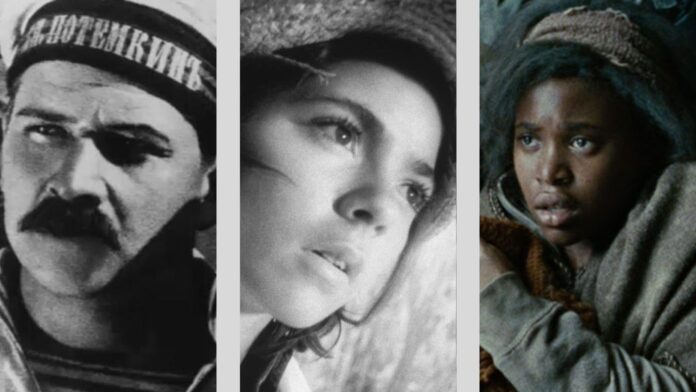How images ignite resistance and shape rebellion.
A revolution begins with an idea. And over the course of time, as people have fought against tyranny, cinema has given those ideas a body—a moving, breathing, choreographed rhythm that condenses an entire nation’s struggle into a harrowing story, a fighting piece of art. In film, rebellion becomes visceral through how it’s seen and felt.
This Film Flight explores how three directors—across the Soviet Union, Cuba, and a dystopian England—translate political unrest into visual expression. These films don’t just tell revolutionary stories, but embody rebellion in their form. The camera can march with the people, witness oppression, or detonate reality through radical editing. Through choreography, framing, and motion, they show how upheaval feels from the ground, how it permeates the air, how it infiltrates our souls.
The Film Flight
Each movie links to where you can stream it.
- Battleship Potemkin (1925, dir. Sergei Eisenstein – Soviet Union)
A silent masterwork of montage, this Soviet film details a naval mutiny and the people’s revolt born from it. Eisenstein’s editing style doesn’t just tell a story—it navigates the emotional response to oppression like an orchestra’s conductor, turning sequences of quick, flashing moments into revolutionary calls to arms. - I Am Cuba (1964, dir. Mikhail Kalatozov – USSR/Cuba)
This fever dream of pre-revolutionary Cuba is unlike anything you’ve ever seen, shot in sweeping long takes that defy gravity and expectation. The camera floats through sugar fields and hotel ballrooms alike, giving cinematic form to the collision between beauty, despair, and uprising. - Children of Men (2006, dir. Alfonso Cuarón – United Kingdom)
Set in a collapsing future, this film tracks the unlikely emergence of hope amid authoritarian decay. Known for its harrowing long takes, it puts the viewer in the midst of chaos, treating revolution not as a symbol, but as a physical, unrelenting experience that must be journeyed to be realized.
How They Speak the Same Visual Language
Though worlds and decades apart, these three films are united by how they use the camera to embody revolution, and altogether showcase the progression of cinema as it explored new and exciting ways to explore the nature of such a fight.
In Battleship Potemkin, editing is the weapon, as Eisenstein’s rapid-fire montage transforms static images into kinetic energy. The Odessa Steps sequence, with its famous staccato rhythm, doesn’t just portray violence, but, in both a meticulous and chaotic manner, sculpts our emotional response to it and the horrors that come with uncontrolled powers. The result is an aesthetic that is unrelenting and enthralling, defeating yet motivating.
Four decades later, I Am Cuba reinvents the revolutionary gaze with hypnotic, floating long takes. The camera glides through contradictions—wealth and poverty, joy and despair—until they collapse under the weight of a unified people’s awakening. The film’s technique is so fluid it feels supernatural, yet our connection to people affected by oppression is deeply grounded, resulting in a transcendent image that treats revolution as poetic inevitability.
Then Children of Men brings us into the 21st century, where Cuarón’s long takes don’t float, but run. The camera doesn’t observe from above, but scrambles beside refugees and flinches from gunfire, never looking away and always keeping us part of the in-the-moment action. It feels immediate, exhausted, and necessary. Where Eisenstein gives us revolution as myth and Kalatozov as momentum, Cuarón gives us revolution as survival.
Each film understands that the visual medium of film isn’t about illustration, but agitation. Their visual styles don’t just represent revolution—they are revolutionary, breaking cinematic norms to mirror political rupture, to force us to think about revolution from the position of people ready to die for it.
Flight Notes: What to Look For
- Watch how each director uses movement—of the camera, of crowds, of editing rhythms—to convey political momentum.
- Consider perspective: where is the camera placed, and whose experience is centered in each scene?
- Pay attention to how each film visually contrasts power and powerlessness, often without saying a word.
More Movies About Revolution
If you’re hungry for more films about revolution, here are five other great options:
- J’Accuse (1919)
- Rome, Open City (1945)
- Z (1969)
- Matewan (1987)
- Judas and the Black Messiah (2021)

